The Dandruff Control Shampoos Market is anticipated to be valued at USD 7,402.1 million in 2025, before reaching USD 16,805.6 million by 2035. This translates into an expansion of USD 9,403.5 million over the decade, equating to a 127% rise in size. The growth trajectory corresponds to a CAGR of 8.5%, indicating a near doubling of the market by the end of the forecast horizon.
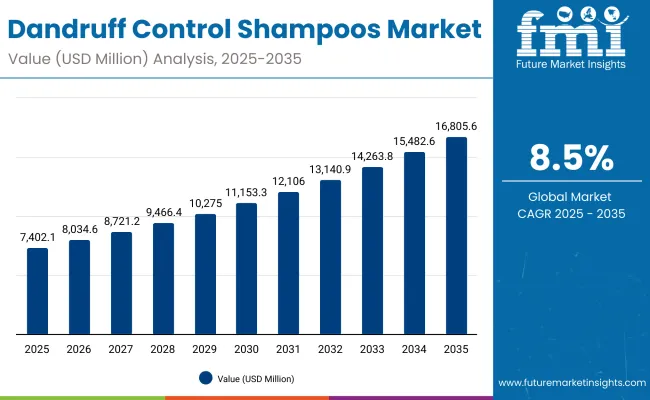
Dandruff Control Shampoos Market Key Takeaways
| Metric | Value |
|---|---|
| Dandruff Control Shampoos Market Estimated Value in (2025E) | USD 7,402.1 million |
| Dandruff Control Shampoos Market Forecast Value in (2035F) | USD 16,805.6 million |
| Forecast CAGR (2025 to 2035) | 8.5% |
Such expansion is expected to be supported by rising consumer focus on scalp health, increasing adoption of dermatologist-recommended products, and the sustained penetration of medicated formulations.
From 2025 to 2030, the market is projected to grow from USD 7,402.1 million to USD 11,153.3 million, contributing USD 3,751.2 million, which represents about 40% of the total decade growth. This phase is expected to be marked by widespread reliance on zinc pyrithione-based solutions and robust traction in mass retail channels. Medicated shampoos, which are estimated to hold a 48.0% share in 2025, are anticipated to consolidate their dominance during this period.
The second half of the forecast, spanning 2030 to 2035, is expected to generate USD 5,652.3 million in additional revenue, accounting for 60% of the total growth. This acceleration is likely to be powered by rapid consumer transition toward herbal and natural formulations, particularly in high-growth markets such as India and China. Anti-flake variants, leading with 46.0% share in 2025, are projected to sustain demand momentum, while e-commerce is expected to emerge as a decisive channel shaping long-term accessibility and consumer preference.
From 2025 to 2035, the market is projected to expand by USD 9,403.5 million, reflecting strong consumer preference for medicated and anti-flake solutions. Growth momentum is expected to be concentrated in emerging markets such as India and China, where herbal and natural formulations are gaining prominence. Competition is anticipated to intensify as premium offerings, e-commerce penetration, and dermatologist-recommended products become the leading differentiators.
The growth of the Dandruff Control Shampoos Market is being driven by rising awareness of scalp health, increasing preference for clinically validated ingredients, and the shift toward medicated and dermatologist-recommended products. Enhanced demand for anti-flake and itch-relief solutions is being supported by continuous innovations in formulations that balance efficacy and safety. Adoption of herbal and natural blends is being accelerated by consumer inclination toward sustainable and chemical-free options, particularly in emerging economies such as India and China. Expanding accessibility through pharmacies, supermarkets, and rapidly growing e-commerce platforms is ensuring wider penetration across demographics. Premiumization trends are being reinforced by heightened willingness among consumers to invest in specialized scalp-care routines. Furthermore, demographic shifts, including urban lifestyles and rising disposable incomes, are creating favorable conditions for long-term demand. The market is expected to maintain strong momentum as functional diversification, digital marketing, and global brand strategies continue to reshape consumer engagement and loyalty.
The Dandruff Control Shampoos Market has been segmented to capture varying consumer needs and ingredient preferences that shape long-term demand. Product types have been classified into medicated shampoos and other variants, reflecting the balance between therapeutic and everyday use. Function-based segmentation highlights the dominance of anti-flake solutions, alongside other categories such as itch relief and scalp soothing, which ensure broad consumer appeal. Active ingredients have been studied to understand the role of zinc pyrithione, herbal blends, and alternative formulations in driving clinical trust and natural positioning. This segmentation outlook demonstrates how product differentiation, functional attributes, and ingredient innovation are expected to sustain competitiveness and direct growth opportunities across global and regional markets over the next decade.
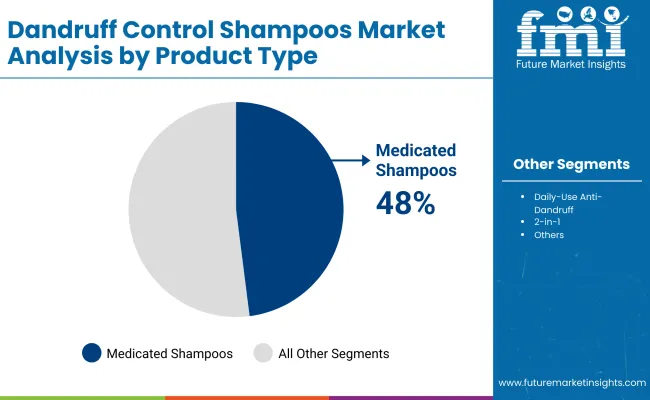
| Product Type | Market Value Share, 2025 |
|---|---|
| Medicated shampoos | 48% |
| Others | 52.0% |
Medicated shampoos are projected to account for 48.0% of the Dandruff Control Shampoos Market in 2025, valued at USD 3,553.01 million. Growth is being reinforced by increasing consumer reliance on dermatologist-recommended solutions that offer clinically proven effectiveness. Such products are often positioned as premium formulations, aligning with the rising willingness of consumers to invest in targeted scalp treatments. Other categories, representing 52.0% of the market and USD 3,849.09 million in 2025, are expected to sustain demand by meeting the needs of daily users who prefer affordable, multifunctional options. The balance between medicated and routine-use shampoos indicates that hybrid innovations combining therapeutic claims with everyday usability are likely to capture future growth potential.
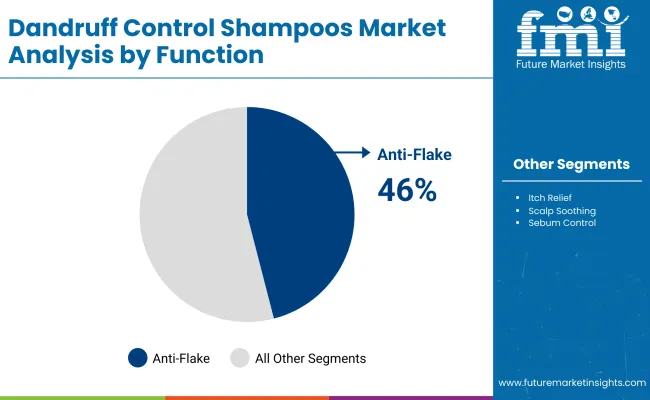
| Function | Market Value Share, 2025 |
|---|---|
| Anti-flake | 46% |
| Others | 54.0% |
The function segment is expected to be led by anti-flake solutions, which are forecasted to hold 46.0% share in 2025, equivalent to USD 3,404.97 million. Demand for this category is being reinforced by consumer focus on visible dandruff control and quick symptom relief, supported by strong clinical validation. Other functions, collectively representing 54.0% of the market at USD 3,997.13 million, are gaining traction through specialized offerings such as itch relief, scalp soothing, and sebum control. This diversification highlights the evolving consumer need for multifunctional care, beyond dandruff elimination. As consumer awareness of scalp health broadens, products addressing both cosmetic and therapeutic benefits are projected to secure stronger positioning, ensuring steady demand across diverse demographics.
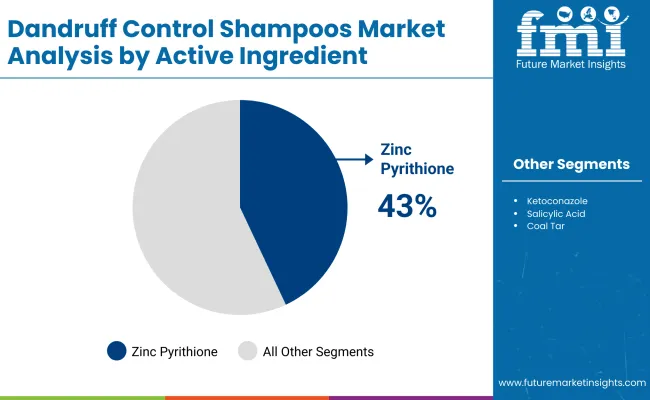
| Active Ingredient | Market Value Share, 2025 |
|---|---|
| Zinc pyrithione | 43% |
| Others | 57.0% |
The active ingredient segment is anticipated to be dominated by zinc pyrithione, which is expected to secure 43.0% share in 2025, amounting to USD 3,182.90 million. Its established effectiveness in clinical studies and widespread consumer trust have ensured continued market leadership. Other ingredients, contributing 57.0% share or USD 4,219.20 million, are being driven by increasing preference for herbal and natural blends such as neem and tea tree oil, alongside chemical alternatives like ketoconazole and salicylic acid. This dynamic reflects a consumer shift toward safer and more sustainable formulations. Regulatory developments around ingredient usage are projected to accelerate innovation cycles, creating opportunities for new blends to capture incremental demand in both mature and emerging markets.
Adoption of the Dandruff Control Shampoos Market is being influenced by evolving consumer health awareness and ingredient innovation, even as safety regulations, raw material volatility, and growing demand for sustainable formulations continue to reshape product development, branding strategies, and distribution models globally.
Regulatory Momentum toward Ingredient Transparency
The market is expected to be accelerated by heightened regulatory scrutiny surrounding scalp-care formulations. Stricter mandates on chemical compositions are compelling manufacturers to reformulate with clinically validated, safe, and transparent ingredients. This regulatory push is anticipated to enhance consumer trust, reinforcing long-term brand equity. Beyond compliance, forward-looking players are projected to leverage transparency as a marketing tool, differentiating products in a crowded marketplace. This driver is particularly relevant in mature regions such as North America and Europe, where consumer awareness of ingredient safety is rising sharply. As labeling standards become standardized and digital platforms promote ingredient education, regulatory-driven trust is forecasted to evolve into a significant competitive differentiator, shaping both product design and purchase behavior over the decade.
Supply-Side Volatility in Herbal Ingredients
Growth potential is expected to be constrained by supply-side instability in herbal and botanical ingredients. Seasonal dependency, regional cultivation limits, and rising demand from adjacent sectors are contributing to raw material unpredictability. Such volatility is likely to exert pressure on pricing strategies and disrupt production scalability. While consumer preference for natural formulations is expanding, inconsistent supply chains may reduce the reliability of herbal-based offerings, particularly in fast-growing markets across Asia-Pacific. This challenge is anticipated to necessitate investment in backward integration, sustainable sourcing partnerships, and alternative ingredient R&D. Unless effectively mitigated, supply volatility is projected to restrain the pace at which herbal formulations capture greater share, thereby slowing one of the most promising growth avenues in the market.
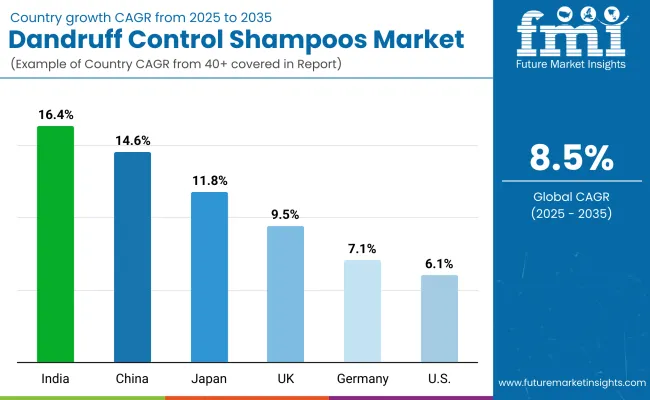
| Country | CAGR |
|---|---|
| China | 14.6% |
| USA | 6.1% |
| India | 16.4% |
| UK | 9.5% |
| Germany | 7.1% |
| Japan | 11.8% |
The global Dandruff Control Shampoos Market is projected to demonstrate diverse regional dynamics, with growth trajectories shaped by consumer health awareness, regulatory frameworks, and ingredient innovation. Asia-Pacific is anticipated to lead expansion, anchored by India at a CAGR of 16.4% and China at 14.6%. India’s trajectory is expected to be accelerated by rising adoption of herbal and natural formulations, aligning with traditional wellness practices and urban consumer preferences. China’s momentum is being reinforced by large-scale demand for medicated shampoos and a widening acceptance of premium scalp-care routines across younger demographics.
Japan is forecasted to grow at 11.8% CAGR, supported by advanced consumer routines and the popularity of high-quality, dermatologist-recommended solutions. In Europe, steady growth is projected, with Germany at 7.1% CAGR and the UK at 9.5%, driven by regulatory mandates on product safety and transparency. Broader Europe is anticipated to maintain a 7.2% CAGR, supported by rising demand for sustainable and clinically validated shampoos.
The USA is expected to expand at a slower CAGR of 6.1%, reflecting maturity in the market but steady adoption of dermatologist-driven and fragrance-free formulations. Overall, regional demand is anticipated to be reshaped by cultural preferences, digital retail channels, and consumer migration toward clinically tested and eco-conscious offerings.
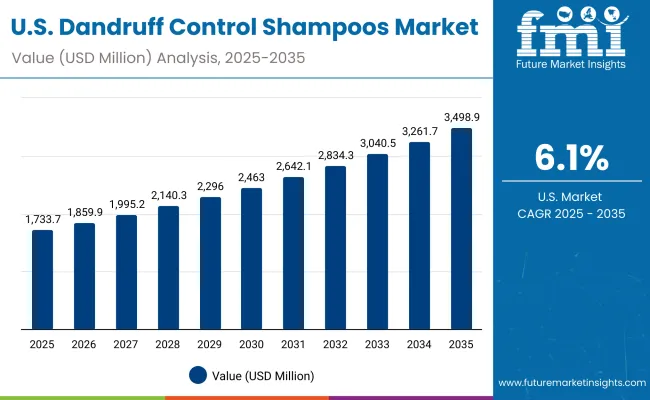
| Year | USA Dandruff Control Shampoos Market (USD Million) |
|---|---|
| 2025 | 1733.79 |
| 2026 | 1859.91 |
| 2027 | 1995.20 |
| 2028 | 2140.33 |
| 2029 | 2296.02 |
| 2030 | 2463.03 |
| 2031 | 2642.19 |
| 2032 | 2834.39 |
| 2033 | 3040.56 |
| 2034 | 3261.73 |
| 2035 | 3498.99 |
The Dandruff Control Shampoos Market in the United States is projected to grow at a CAGR of 7.27%, rising from USD 1,733.79 million in 2025 to USD 3,498.99 million by 2035. This growth is supported by increasing consumer awareness of scalp health, greater reliance on dermatologist-driven formulations, and the strong presence of leading global brands. Premium positioning of medicated shampoos is expected to strengthen, while fragrance-free and clinically tested products are likely to see higher uptake due to safety concerns. Digital retail channels and subscription-based models are anticipated to play an important role in expanding access and personalization.
The Dandruff Control Shampoos Market in the UK is projected to expand at a CAGR of 9.5% through 2035. Growth is expected to be guided by clinical positioning, with dermatologist-endorsed formulas favored in pharmacies and large grocers. Premium anti-flake lines are likely to gain depth as consumers trade up for proven efficacy and sensitive-scalp claims. Private labels are anticipated to sharpen value competition, encouraging established brands to differentiate via scalp microbiome messaging and transparent ingredient disclosure. Digital pharmacies and retailer marketplaces are forecasted to amplify access and auto-replenishment.
Key insights:
The Dandruff Control Shampoos Market in India is forecasted to grow at a CAGR of 16.4% through 2035. Expansion is expected to be underpinned by rapid urban adoption of specialized scalp routines and strong cultural affinity for herbal actives. Ayurveda-aligned blends with tea tree and neem are anticipated to scale in both modern trade and e-commerce, while medicated formats are set to build credibility via dermatologist outreach in metros and tier-2 cities. Price-point stratification is likely to widen, enabling premiumization without compromising mass accessibility.
Key insights:
The Dandruff Control Shampoos Market in China is expected to register a CAGR of 14.6% to 2035. Momentum is projected to be shaped by science-forward narratives, with zinc pyrithione and ketoconazole lines gaining traction alongside premium herbal hybrids. Social commerce and KOL-driven education are anticipated to accelerate regimen adoption, particularly among younger users with scalp sensitivity concerns. Cross-border and domestic premium brands are expected to compete on efficacy verifications, irritation testing, and clean-label clarity. Tiered portfolios are likely to capture both mass retail and boutique pharmacy channels.
Key insights:

| Country | 2025 |
|---|---|
| USA | 23.4% |
| China | 12.0% |
| Japan | 7.0% |
| Germany | 15.4% |
| UK | 8.1% |
| India | 4.9% |
| Country | 2035 |
|---|---|
| USA | 20.8% |
| China | 12.9% |
| Japan | 8.4% |
| Germany | 13.4% |
| UK | 7.3% |
| India | 5.9% |
The Dandruff Control Shampoos Market in Germany is projected to grow at a CAGR of 7.1% through 2035. Steady expansion is expected to be supported by pharmacy leadership, stringent safety expectations, and preference for fragrance-reduced formulas. Medicated offerings are anticipated to maintain authority, while eco-designed packaging and certified ingredients are set to influence shelf choice. Omni-channel journeys are likely to blend advice from dermatology portals with in-store pharmacist guidance, sustaining higher compliance and repurchase rates.
Key insights:
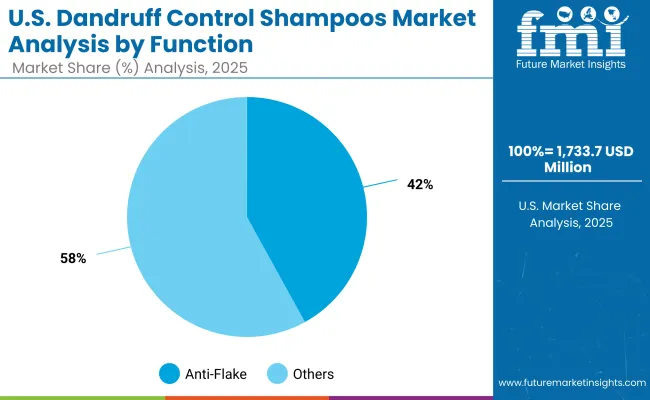
| USA By FUNCTION | Market Value Share, 2025 |
|---|---|
| Anti-flake | 42% |
| Others | 58.0% |
The Dandruff Control Shampoos Market in the United States is projected at USD 1,733.79 million in 2025. Anti-flake formulations contribute 42%, while other functions account for 58%, highlighting a broader preference for multi-symptom relief beyond visible dandruff control. This tilt toward diversified functions is being shaped by rising consumer demand for scalp soothing, itch relief, and sebum management, which extend benefits to daily-use shampoos and specialized care alike. The prominence of non-anti-flake solutions reflects an evolving understanding of scalp health, where preventive and holistic care is increasingly emphasized over symptomatic treatment alone. Premium product lines are expected to incorporate multifunctional attributes, combining therapeutic claims with cosmetic benefits to drive repurchase. Retailers and e-commerce platforms are anticipated to amplify this trend by promoting bundled offerings that address multiple scalp concerns.
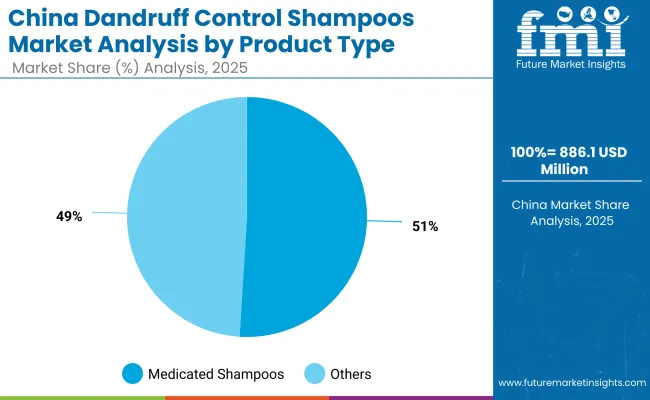
| China By product type | Market Value Share, 2025 |
|---|---|
| Medicated shampoos | 51% |
| Others | 49.0% |
The Dandruff Control Shampoos Market in China is projected at USD 886.16 million in 2025. Medicated shampoos contribute 51%, while other variants account for 49%, reflecting a near-balanced preference between therapeutic and everyday-use formulations. The dominance of medicated products is being reinforced by increasing trust in dermatologist-approved solutions and heightened consumer awareness of scalp disorders in urban centers. At the same time, the strength of non-medicated shampoos underscores the role of herbal and natural blends, which align with cultural affinity for traditional remedies and growing demand for chemical-free options. This balance suggests that hybrid formulations combining clinical validation with natural ingredients are expected to drive the next phase of category expansion. E-commerce platforms and social commerce channels are anticipated to amplify this growth by promoting transparent labeling and consumer education, particularly among younger demographics.
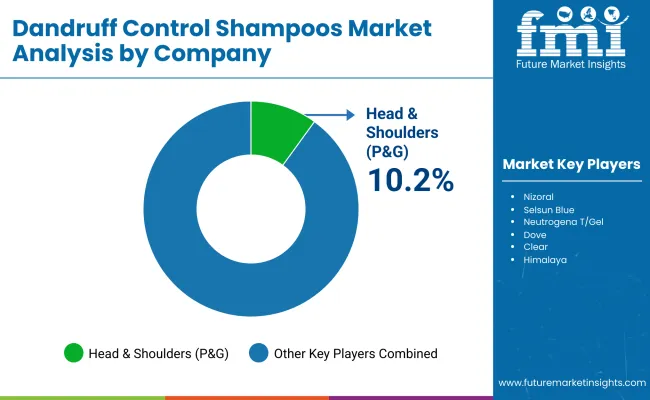
| Company | Global Value Share 2025 |
|---|---|
| Head & Shoulders (P&G) | 10.2% |
| Others | 89.8% |
The Dandruff Control Shampoos Market is moderately fragmented, with global leaders, regional challengers, and niche-focused specialists competing to capture evolving consumer demand. Head & Shoulders, owned by Procter & Gamble (P&G), is expected to dominate globally with a value share of 10.2% in 2025, reflecting its strong brand equity, clinical positioning, and unmatched retail penetration. Its dominance is anticipated to be reinforced by consistent innovation in anti-flake formulations, large-scale advertising, and extensive availability across pharmacies, supermarkets, and e-commerce platforms.
Other prominent brands such as Nizoral, Selsun Blue, Clear (Unilever), Dove, Neutrogena T/Gel, The Body Shop, Jason Natural, Biolage, and Himalaya collectively account for the remaining 89.8% share. These companies are expected to focus on differentiating through herbal actives, fragrance-free options, and dermatologist-recommended credentials. Growth among mid-sized players is anticipated to be supported by e-commerce strategies, clean-label positioning, and localized product development tailored to regional scalp health needs.
Competitive differentiation is projected to shift from simple anti-dandruff claims to holistic scalp-care ecosystems, where multifunctional shampoos, bundled regimens, and sustainability credentials play a decisive role. Subscription-driven digital sales, personalized product recommendations, and transparent ingredient disclosure are expected to redefine long-term brand loyalty and consumer trust.
Key Developments in Dandruff Control Shampoos Market
| Item | Value |
|---|---|
| Market value and units | USD 7,402.1 million (2025); USD 16,805.6 million (2035); CAGR 8.5% |
| Time horizon | 2025 to 2035 |
| Product type | Medicated shampoos; Others (daily-use anti-dandruff, 2-in-1, scalp treatments) |
| Function | Anti-flake; Others (itch relief, scalp soothing, sebum control) |
| Active ingredient | Zinc pyrithione; Ketoconazole; Salicylic acid; Coal tar; Herbal blends (tea tree, neem) |
| Distribution channels | Pharmacies/drugstores; Mass retail; E-commerce; Salons & professional |
| Regions covered | North America; Europe; East Asia; South Asia & Pacific; Latin America; Middle East & Africa |
| Countries covered | United States; China; India; Japan; Germany; United Kingdom |
| Leading segments (2025) | Medicated shampoos 48.0%; Anti-flake 46.0%; Zinc pyrithione 43.0% |
| Competitive landscape | Head & Shoulders (P&G) 10.2% global share (2025); Other notable brands: Nizoral; Selsun Blue; Neutrogena T/Gel; Dove; Clear (Unilever); The Body Shop; Jason Natural; Biolage; Himalaya |
| Demand drivers | Dermatologist-recommended efficacy; premiumization; herbal/natural adoption; digital retail personalization |
| Constraints | Ingredient regulation shifts; herbal supply volatility; price sensitivity in mass retail |
| Additional attributes | Country CAGRs: India 16.4%, China 14.6%, Japan 11.8%, UK 9.5%, Europe 7.2%, USA 6.1%; channel mix expected to tilt toward e-commerce; regimen bundling and transparent labeling anticipated to strengthen loyalty |
The global Dandruff Control Shampoos Market is estimated to be valued at USD 7,402.1 million in 2025.
The market size for the Dandruff Control Shampoos Market is projected to reach USD 16,805.6 million by 2035.
The Dandruff Control Shampoos Market is expected to grow at a CAGR of 8.5% between 2025 and 2035.
The key product types in the Dandruff Control Shampoos Market are medicated shampoos and others, including daily-use anti-dandruff, 2-in-1 formulations, and scalp treatments.
In terms of function, the anti-flake segment is expected to command a 46.0% share in the Dandruff Control Shampoos Market in 2025.






Full Research Suite comprises of:
Market outlook & trends analysis
Interviews & case studies
Strategic recommendations
Vendor profiles & capabilities analysis
5-year forecasts
8 regions and 60+ country-level data splits
Market segment data splits
12 months of continuous data updates
DELIVERED AS:
PDF EXCEL ONLINE
Anti-Dandruff Agents Market Size and Share Forecast Outlook 2025 to 2035
Anti-Dandruff Shampoos Market Analysis - Size and Share Forecast Outlook 2025 to 2035
Controllable Shunt Reactor for UHV Market Size and Share Forecast Outlook 2025 to 2035
Control Room Solution Market Size and Share Forecast Outlook 2025 to 2035
Control Knobs for Panel Potentiometer Market Size and Share Forecast Outlook 2025 to 2035
Controlled-Release Drug Delivery Technology Market Size and Share Forecast Outlook 2025 to 2035
Controlled Environment Agriculture (CEA) Market Size and Share Forecast Outlook 2025 to 2035
Control Cable Market Size and Share Forecast Outlook 2025 to 2035
Control Towers Market Size and Share Forecast Outlook 2025 to 2035
Controlled & Slow Release Fertilizers Market 2025-2035
Controlled Intelligent Packaging Market
Biocontrol Solutions Market Size and Share Forecast Outlook 2025 to 2035
Biocontrol Agents Market Size and Share Forecast Outlook 2025 to 2035
Oil Control Shampoo Market Size and Share Forecast Outlook 2025 to 2035
LED Control Unit Market Size and Share Forecast Outlook 2025 to 2035
Sun Control Films Market Size and Share Forecast Outlook 2025 to 2035
CNC Controller Market Size and Share Forecast Outlook 2025 to 2035
PID Controller Market Size and Share Forecast Outlook 2025 to 2035
Market Share Breakdown of Sun Control Films Manufacturers
PLC Controlled Packing Machine Market Trends – Forecast 2024-2034

Thank you!
You will receive an email from our Business Development Manager. Please be sure to check your SPAM/JUNK folder too.
Chat With
MaRIA